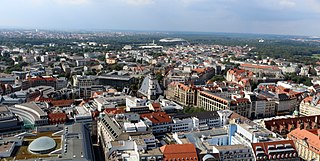
Leipzig is the most populous city in the German state of Saxony. The city has a population of 628,718 inhabitants as of 2023. It is the eighth-largest city in Germany and is part of the Central German Metropolitan Region. The name of the city is usually interpreted as a Slavic term meaning place of linden trees, in line with many other Slavic placenames in the region.

A bear claw is a sweet, yeast-raised pastry, a type of Danish, originating in the United States during the mid-1910s. In Denmark, a bear claw is referred to as a kam. France also has an alternate version of that pastry: patte d'ours, created in 1982 in the Alps. The name bear claw as used for a pastry is first attested in March 1914 by the Geibel German Bakery, located at 915 K Street in downtown Sacramento. The phrase is more common in Western American English, and is included in the U.S. Regional Dialect Survey Results, Question #87, "Do you use the term 'bear claw' for a kind of pastry?"

Hans Wilhelm Auer was a Swiss-Austrian architect best known for his design of the Swiss Bundeshaus (1894–1902) in Bern.

Berner Haselnusslebkuchen are traditional Christmas cakes (Lebkuchen) from Bern, Switzerland. Made from ground hazelnuts, they are not to be confused with the Berner Honiglebkuchen, another Bernese specialty.

The Monday demonstrations were a series of peaceful political protests against the government of the German Democratic Republic (GDR). The demonstrations began on 4 September 1989, leading to the Peaceful Revolution in the GDR: the fall of the Berlin Wall, the collapse of the government, and German reunification.

Karl Julius Schröer was an Austrian linguist and literary critic. He was the son of the educator and writer Tobias Gottfried Schröer (1791–1850).

Maria Janitscheknée Tölk was a German writer of Austrian origin. She wrote under the pseudonym of Marius Stein.
The following is a timeline of the history of the German city of Leipzig.

Kapitaï and Koba were two areas on the coast of West Africa which were the object of German colonial initiatives in 1884 and 1885. They lay between the Pongo and Dubréka rivers, south of Senegal and Gambia in modern Guinea; in the terms commonly used in the 19th century they were considered part of Senegambia. The short-lived German colony there was known as the Dembiah colony or Colinsland.
Horst Günter was a German operatic baritone and voice teacher.

Julius Lieban was an Austro-German operatic tenor.
Rudolf Brinkmann was a German operatic baritone.

Georg Emanuel Opiz was a Bohemian German painter and graphic artist. He also wrote some now-forgotten historical novels, under the pseudonym "Bohemus".

Hubert Hans Ritter was a German architect, urban planner and building official.

Gustav Wohlgemuth was a German choral conductor and composer.
The Allgemeine deutsche Musikzeitung was a musical specialist journal, which appeared from 1874 to 1884, first in Leipzig and Kassel, then in Charlottenburg. In the early years it was called Allgemeine Deutsche Musik-Zeitung – Wochenschrift für das gesammte musikalische Leben der Gegenwart.
Henriette Ottenheimer was a German Jewish poet.
Ernst Wachter was a German operatic bass and music educator.












